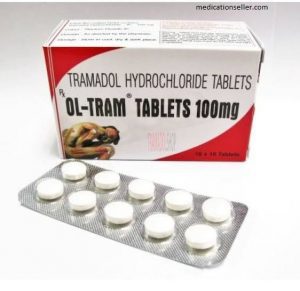Tramadol is an SNRI (serotonin/norepinephrine reuptake inhibitor) and a centrally acting synthetic opioid analgesic that is chemically similar to codeine and morphine. Tramadol is typically regarded a lower-risk opioid alternative for the treatment of moderate to severe pain due to its favourable tolerability profile and multimodal mechanism of action. On the World Health Organization’s pain scale, it’s a Step 2 choice with roughly a tenth of the strength of morphine. Tramadol differs from other classic opioid drugs in that it impacts monoamines by altering the actions of neurotransmitters involved in pain modulation, such as serotonin and norepinephrine, which activate descending pain inhibitory pathways. The effects of tramadol on serotonin and norepinephrine are similar to those of other SNRI antidepressants such duloxetine and venlafaxine.
Tramadol, like other opioid drugs, has the potential to cause tolerance, dependency, and misuse. There is a dose-related danger of overdose, respiratory depression, and mortality when taken at larger dosages or in combination with other opioids. Tramadol, unlike other opioid drugs, can cause seizures and serotonin syndrome, especially when used with other serotonergic pharmaceuticals.
Pharmacodynamics of Tramadol
Central nervous system
Tramadol, unlike morphine, hasn’t been demonstrated to trigger histamine release. Tramadol has no effect on heart rate, left-ventricular function, or cardiac index at therapeutic levels. There has been an observation of orthostatic hypotension.
Tramadol causes respiratory depression by acting directly on the respiratory centres in the brain stem. Respiratory depression is caused by a decrease in the brain stem’s reactivity to both increased CO2 tension and electrical stimulation. Tramadol works by inhibiting the cough reflex by acting directly on the cough centre in the medulla. Antitussive effects can occur at dosages that are lower than those needed for analgesia.
Even in complete darkness, tramadol promotes miosis. Although pinpoint pupils are a symptom of opioid overdose, they are not diagnostic (e.g., pontine lesions of hemorrhagic or ischemic origin may produce similar findings).
Gastrointestinal Tract and Other Smooth Muscle
Tramadol induces a decrease in motility in the antrum of the stomach and the duodenum, as well as an increase in smooth muscle tone. Food digestion is delayed in the small intestine, and propulsive contractions are reduced. Constipation is caused by a reduction in propulsive peristaltic waves in the colon, as well as an increase in tone to the point of spasm. Reduced gastric, biliary, and pancreatic secretions, spasm of the sphincter of Oddi, and transitory increases in serum amylase are all possible opioid-induced consequences.
Endocrine System
Tramadol-induced hyponatremia has been recorded infrequently, generally in patients with predisposed risk characteristics, such as elderly patients and/or patients taking concurrent drugs that might cause hyponatremia (e.g., antidepressants, benzodiazepines, diuretics). Hyponatremia appears to be caused by the syndrome of inappropriate antidiuretic hormone secretion (SIADH) in certain cases, and was treated with tramadol withdrawal and proper medication (e.g., fluid restriction). Patients with predisposed risk factors should be monitored for signs and symptoms of hyponatremia when taking tramadol.
Abuse and Misuse of Tramadol
Tramadol, like all opioids, has the potential for abuse and overuse, leading to overdose and death. As a result, tramadol should be prescribed with caution and treated with care.

































































